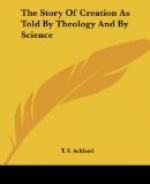[Footnote: It is thought probable that this process is complete, or nearly so, in the moon. If this be the case, it is in all probability in progress in the case of the earth, though, owing to the much greater bulk of the latter, it occupies a longer period. —Lockyer, Lessons in Astronomy, p. 93.] be declining in intensity; but the rate of that decrease is unknown; it may be in arithmetical, or it may be in geometrical progression. It is, then, by no means impossible that changes, which now only become discernible with the lapse of centuries, might, at some past period of our globe’s history, have been the work of years only. Nor is it at all probable that the present rate of change, which is assumed as the basis of the calculation, is known with any approach to accuracy. Exact observations are of very recent date; both the inclination and the means for making them are the growth of the last two centuries, and the changes which have to be ascertained are of a class peculiarly liable to modification from a variety of local and temporary causes, so that a very much longer period must elapse before we can arrive at average values which may be relied on as even approximately accurate.
Another circumstance, which seems to merit more attention than it has received, is the very frequent recurrence in Greek mythology of allusions to creatures which have been usually regarded as the creations of a poetic fancy, but which bear a strong resemblance to the Saurian and other monsters of the Oolite and Cretaceous formations. Of course, it is not impossible that these things may have been purely poetic imaginings; but, if so, it is very remarkable that such realizations of those imaginings should be afterwards discovered. It would seem much more probable that these legends were exaggerated traditions of creatures which actually existed when the first colonists reached their new homes, in numbers comparatively small, but still sufficient to occasion much danger and alarm to the early settlers, and to cause their destroyers to be regarded as among the greatest heroes of the time and the greatest benefactors of mankind. The Hindoo tradition of the tortoise on whose back stands the elephant which upholds the world, and the account of Leviathan in the Book of Job, seem to point in the same direction. [Footnote: For additional instances see Tylor’s Early History of Mankind, p. 303.]
But, after all, the question is not one of a few thousands of years more or less, but of six common days, or many thousands of years. It may help us to arrive at a right conclusion on the subject if we endeavour to ascertain, in the first instance, whether there are any strongly-marked indications that the writer of the first chapter of Genesis did possess some accurate information on some points in the history of Creation which he was not likely to obtain by his own researches. For this purpose we will place in parallel columns the leading facts recorded by Moses, and a table of the successive formations of the rocks, abridged from the last edition (1871) of Sir C. Lyell’s Student’s Geology. This process will bring to light certain coincidences which may serve as landmarks for our investigation.




